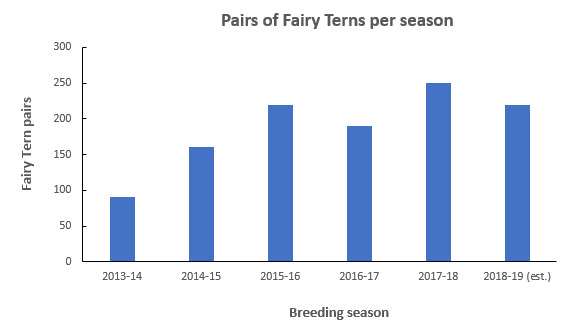Fairy Terns
The Rous Head Fairy Tern Sanctuary, established by Fremantle Ports at Rous Head in 2013, is an ongoing voluntary project on reclaimed land comprising design, construction and operation of a managed conservation area for a listed threatened bird species, the Australian Fairy Tern.
The sanctuary was the most successful breeding site for Fairy Terns in the Perth metropolitan area for a number of years. The adult breeding population grew from 90 adult pairs in 2013-14 to 250 adult pairs in 2017-18 and about 220 pairs in 2018-19.

Prior to the creation of the area, Fairy Terns attempted breeding at the port in pairs or small groups. Eggs were laid in shallow sand scrapes and vulnerable to destruction from humans, dogs or vehicles.
The success of the conservation area is due to its location and design, based on advice from Australian conservation authorities and particularly the Western Australian Museum. The site was elevated and located with direct ocean access where Fairy Tern prey (bait fish) is abundant and close.
.jpg?sfvrsn=46db2a90_0)
Fairy Terns flying over the seawall at the sanctuary (Photo: Claire Greenwell)
Fremantle Ports engaged with the community and users of the port area to consider site design options and to garner community support for the site. Fremantle Community Men's Shed painted model replicas of the terns that were planted at the site to encourage prospecting terns to land. Birdlife Australia contributed to the development of interpretive signage drawing on its national experience.
The birds make their nests in a scrape in shelly sand and lay one to two speckled eggs between November and March. Sandy material dredged in the Inner Harbour deepening of 2010 was used to create the breeding conditions favoured by Fairy Terns. The breeding sanctuary is fenced to protect the nesting colony from intrusion and to prevent the chicks from straying onto the adjacent pedestrian and cycle pathway. The site was replenished with shelly material before the 2017-18 breeding season.
In 2016, CCWA received a grant from Fremantle Ports towards establishing a WA Fairy Tern Conservation Network to coordinate the CCWA citizen-science project activities and to facilitate conservation initiatives with land and water managers and community volunteers. The network page now operates an email group for general communications and a Facebook group to facilitate the submission of citizen-science observations, particularly where these are supported by digital photographs of banded birds, the numbered bands themselves and/or fish being carried for courtship or to feed chicks. Fremantle Ports continues to work closely with the network.
Chicks on site are banded annually as part of CCWA’s Fairy Tern Citizen Science Project to understand more about Fairy Tern population movements, sub-regional relationships and overall population health. The banding is being supervised by Dr Nic Dunlop, a terrestrial and marine ecologist with a special interest in seabird population dynamics, and involves an experienced team of volunteers.
The bird bands are provided by the Australian Government under the auspices of the Australian Bird and Bat Banding Scheme (ABBBS). The ABBBS manages collection of information on threatened and migratory bird and bat species and has issued authority to Dr Dunlop to supervise the banding at the sanctuary.
Want to know more about Fairy Terns? See Fairy Tern information.
International recognition
PIANC, the World Association for Waterborne Transport Infrastructure, has given the fairy tern sanctuary an official Working with Nature Certificate of Recognition. Fremantle is the first Australian port to receive PIANC Working with Nature accreditation.
.jpg?sfvrsn=a6dfbb15_0)
Find out how you can explore the port or get ferry and cruise info...
